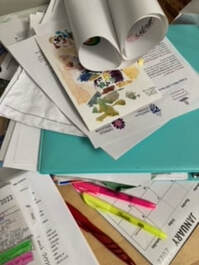 This semester, I gave my online students a new assignment. A Hmm… Collection, which I adapted from Doren and Millington (2019). I asked my students to collect and document 10 objects from their work spaces and reflect on the objects as well as the process. Halfway through grading their responses, I decided that it was only fair to do the same assignment as a way for them to get to know me a little better. Two collections emerged. The first, I realized, was something I began years earlier in the pedagogy of the home post, documenting the mess of my overlapping spaces of work, homeschool, artmaking and play.
Teachers, especially early childhood educators, know all about stations. My art teacher students frequently use this as a way to encourage exploration of materials and center student learning and meaning making. I recently heard about a concept called chaos theory from another art educator. I haven’t dug into this concept too deeply, but basically, play (and learning) happens on the edge of chaos. How do we create spaces conducive to making unforeseen connections, critical thinking, creativity and play, but not careening into chaos that paralyzes? We (and by we I mean I designed and my husband built) put in a large workspace in our front room. There are areas for reading, working, storing, and staging. At various times it is cluttered with multiple projects (right now, I have a pile of homeschool planning, a pile of course materials, a pile of follow up tasks, and a pile of stories that our oldest is midway through typing up. Plus other random gifts that my middle offers from time to time, and odds and ends from projects, plant starts, art supplies, and more. There are, however, areas of quiet that I keep fastidiously picked up. The guest room. The sitting area where my diplomas hang and my personal quiet time materials are housed along with important reminders of my work, family, friends, and faith. A place to sit and refocus. These spaces keep us just on the edge of chaos. The second collection came about as I was thinking about an exhibition centered around grief. How does grief and workspaces intersect? Sometimes we’re able to prepare for grief. My grandmother was the first person I lost. She went in for heart surgery in May 2008, and never came home. I don’t remember the specifics of the complications, but I do remember taking my violin to the lounge at the rehab facility to play Christmas carols that December, as my aunts and uncles and parents and grandpa all spent an afternoon together. A few days later, two days before Christmas, she passed away. I was away at college that fall and made a point to write cards to her. I spent a lot of time going to the same handful of places to paint small watercolors, marking the time. I tacked each of these paintings up on my studio wall, unintentionally creating a grid. By the end of the year, I had made myself a calendar, perhaps not of days, but one marking out this time of change.
References
Doren, M. & Millington, A. (2019). A pedagogy for reflective practice: Art and Design thinking made visible using an online learning portfolio. International Journal of ePortfolio, 9(2), 75-86. For more on play and artmaking, see Walker, S. (2022). Artmaking, Play and Meaning Making. Davis. This was an interesting blog post on chaos theory in art education, though not the same context of the conversation that introduced me to chaos theory: Hillis, N. (2020, May 20). Creativity, Chaos Theory and the Space Between the Notes. The source for the "edge of chaos" idea was Arthur Battram via Shana Cinquemani, who has numerous publications on early childhood art education.
0 Comments
Leave a Reply. |
Ruth M. SmithCommunity arts educator and researcher. Drinking coffee. Home educating. Making art. Listening intentionally. Categories
All
Archives
February 2022
|
 RSS Feed
RSS Feed
